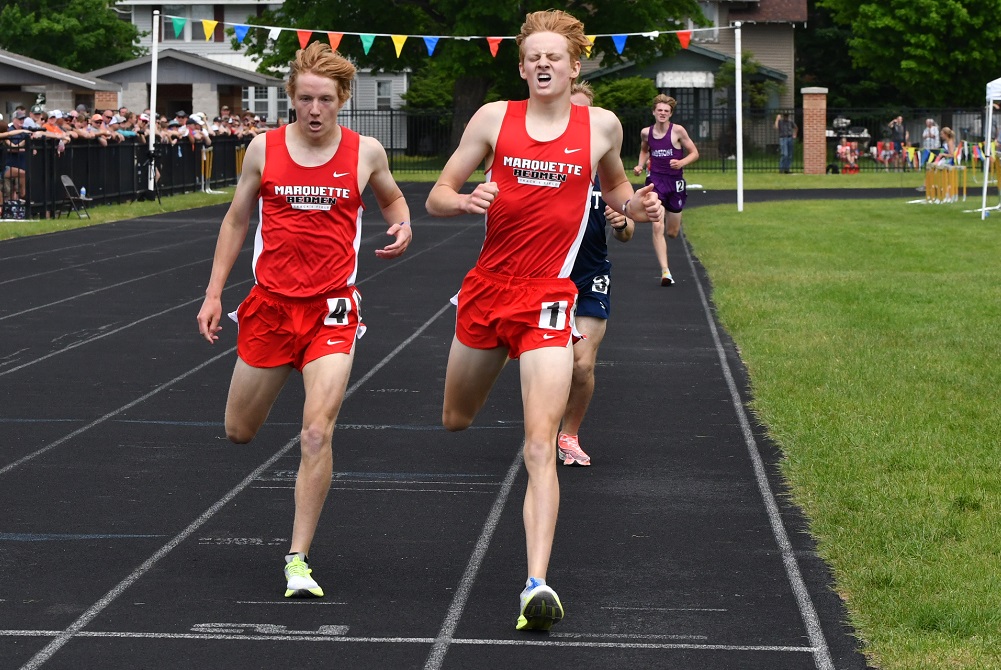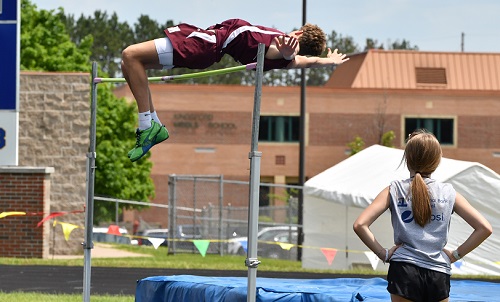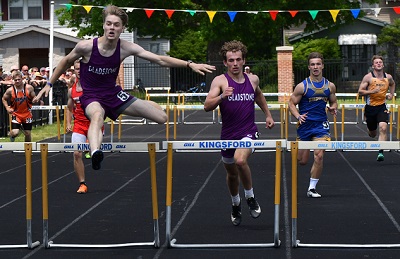
Marquette Caps Another Dominating Run as UPD1's Best
By
John Vrancic
Special for MHSAA.com
June 6, 2021
KINGSFORD — The Marquette boys have been the track & field frontrunners in the Upper Peninsula all season.
They also finished the season that way by scoring 140 points in the Upper Peninsula Division 1 Finals on Saturday at Kingsford. Gladstone – which had won the last Finals in 2019 – followed with 93 points, and third-place Kingsford had 65.
“Hats off to Kingsford for putting on such a fine meet,” said Marquette coach Kyle Detmers. “We had some good performances and our seniors were good leaders. Kam Karp had a great day, and the Vanderschaaf brothers going 1-2 in the 1,600 was huge. Cullen Papin nearly won the 800, and Owen Beauchamp, Truman Langlois and Tyranon Dahlin had nice performances.”
Temperatures hovered in the low 90s with a heat index of 99, which is believed to be the hottest U.P. Finals on record.
Sophomore Colin Vanderschaaf took the 1,600-meter run in four minutes, 31.82 seconds, edging his twin brother Carson by nine hundredths of a second.
Carson Vanderschaaf then won the 3,200 (10:24.93), and Papin was clocked at 2:01.41 in the 800, just behind Escanaba senior Derek Douglas (2:00.68).
 “It was great,” said Carson Vanderschaaf said. “I was really happy with my 1,600. I took a more conservative approach because of the heat. The breeze helped a little on the home stretch, but it was still hot.
“It was great,” said Carson Vanderschaaf said. “I was really happy with my 1,600. I took a more conservative approach because of the heat. The breeze helped a little on the home stretch, but it was still hot.
“I’m really excited for cross country this summer. With a summer full of training, I think I can improve.”
Karp won the 200 (23.24) and was runner-up to Calumet’s Dryden Nelson on a lean in the 100 (11.32) with Beauchamp third (11.44).
Nelson also took long jump at 20 feet, 6 inches with Dahlin runner-up (21-1½).
Lincoln Sager added a first for Marquette in the 400 (51.81), edging Houghton’s Donovan Dueweke by nine hundredths of a second.
Douglas’s effort on this hot and humid day was eight hundredths of a second better than his winning 800 time in Tuesday’s Northern Michigan Meet of Champions at Gaylord.
“It was a challenge trying to stay cool,” said Douglas, who will be running for St. Scholastica College in Duluth, Minn. next season. “I was sitting in front of a fan with icepacks on me, trying to stay cool.
“It feels great to get a U.P. Finals win. All the hard work I put in paid off.”
 Menominee junior Brady Schultz set the UP Division 1 Finals record and tied the school record in high jump at 6-8, edging Gladstone senior Ethan Milan who matched his own school record at 6-6. Dahlin placed third (5-10).
Menominee junior Brady Schultz set the UP Division 1 Finals record and tied the school record in high jump at 6-8, edging Gladstone senior Ethan Milan who matched his own school record at 6-6. Dahlin placed third (5-10).
“It’s good to have that competition,” said Schultz. “We really help each other out. I was happy to get the U.P. record and tie the school record. It really helps to clear 6-8. I was tired when we got to 6-9.”
The previous UPD1 record (6-5) was set by Kingsford’s Jake Richmond in 2004.
Milam previously cleared 6-6 in a triangular meet at Gladstone on May 11.
“My friend Lucas Hughes told me to keep saying to myself ‘you’re going to make it,’” said Milam. “I’m definitely pleased with my season. I set multiple records. Taking a year off (due to COVID-19) made a big difference. I had a chance to take a break. It was definitely refreshing to get track back this year.”
Gladstone senior Blake Servant was a double champion, winning the discus (151-1) and 110 hurdles (15.53), while teammate Calvin Thibault edged Servant in the 300 hurdles (40.80).
PHOTOS: (Top) Marquette's Colin Vanderschaaf (right) out-strides twin brother Carson in the 1,600 Saturday at Kingsford. (Middle) Menominee's Brady Schultz wins the high jump with a UPD1 record 6-8. (Below) Gladstone's Calvin Thibault, left, edges teammate Blake Servant in the 300 hurdles. (Photos by Cara Kamps. Click to see more at RunMichigan.com.)

Track Gaining Speed Toward Future with Electronic Starting Devices
By
Steve Vedder
Special for MHSAA.com
May 23, 2023
Aubrey Greenfield thinks it might be the perfect time to reevaluate 130 years of tradition.
For a number of reasons, from technical to personal, the Oxford senior sprinter believes it makes sense for the crack of a starting pistol to be eliminated from high school track meets.
Because track meets would benefit in various ways from lowering costs to easier setup at meets to the human factor of competitors not having to flinch at the crack of a pistol shot, Greenfield believes the sport has a chance to embrace new technology – electronic starting devices (ESD).
In essence, an ESD replaces the starting pistol with a light flash, tone sound or both to begin a race.
"High school sports should put the athlete first," Greenfield said. "We should promote sports, and eliminating starting pistols promotes health in terms of PTSD or trauma for athletes and spectators and that would be good. I would like to think people would say that's a good idea."
In fact, Greenfield would go as far as to say if there was not an implementation of electronic starting devices, many of her teammates would have considered giving up the sport.
"If it's something that helps us compete safely, we're all for it," she said.
Greenfield's opinion apparently is spreading. Michigan High School Athletic Association senior assistant director Cody Inglis said the use of ESD makes it both affordable for meet starters and sensible for athletes and fans to rethink the use of starting pistols. While the MHSAA is not mandating electronic starting devices, it does promote the use of what Inglis calls "emerging technology." He notes that ESD are becoming the norm for organizations such as USA Track & Field, the NCAA and an increasing number of high schools.
 "I think we have to embrace new technology, and we think this will be something that takes hold," Inglis said.
"I think we have to embrace new technology, and we think this will be something that takes hold," Inglis said.
A key part of embracing ESD is the human element. The tragic Oxford High School shooting Nov. 30, 2021, that took the lives of four students while injuring seven others should not be relived even for a fleeting instance at a high school sporting event. Oxford athletic director Tony DeMare said the school began using ESD at every meet, including the MHSAA Lower Peninsula Division 1 Finals last June. He said that decision was embraced by virtually all schools Oxford encountered.
"We were very convinced that the alternative (of ESD) would promote a healthy attitude," DeMare said. "We were overwhelmed with the positive response. If a school was on the fence about it or might not be for it, I think we've started to see the tide turn in favor of people willing to listen and learn about electronic starting devices."
Inglis said the MHSAA is acutely aware of what the crack of a starting pistol can mean to athletes and fans.
"It's unimaginable what Oxford went through, and this is a small way we can help," he said. "We look at a (starting pistol) and think, ‘Could we do something else?’ It's a way of helping to solve a problem."
Over the last several years, the MHSAA has embraced finding an alternative to starting pistols. Inglis noted the discussion started with the cost and diminishing availability of 32-caliber ammunition that meet starters use. A box of ammunition, if it can be found, is around $75 a box.
In addition to cost, there is potential damage from excessive exposure to 150-plus decibels of sound generated by the traditional 32-caliber blanks. Medical studies show damage to ears caused by decibel levels above 120 dB.
The tragedy at Oxford accelerated the conversation.
Inglis said the cost of ESD can be likened to a school sinking money into artificial surfaces at football fields. Yes, there is a great cost at first, but over time money is ultimately saved. An ESD system itself ranges between $200 and $500. Speakers also may need to be purchased, but with ESD starting events like the 800 and 1,600-meter relays positioned near the outside lanes 8, 7, 6 and 5 would result in improved hearing by athletes at the start of a race.
There is one challenge with ESD that track administrators are working to overcome – lighting conditions that lessen the ability to see the ESD’s LED light or strobe when the button is pressed by a starter to begin a race. But that vision difficulty resulting from clear blue skies and backgrounds of setting suns can be substantially improved by incorporating a black background with an ESD – something as simple as a starter holding up black cardboard behind the lighting mechanism at the start of an event.
Inglis said when all factors are considered, the use of ESD makes sense.
 "With the climate we live in nowadays, no lookalike guns is good," he said. "We're not mandating this. But people are saying this is affordable."
"With the climate we live in nowadays, no lookalike guns is good," he said. "We're not mandating this. But people are saying this is affordable."
While switching to ESD would break 130 years of tradition, the timing could be a step forward, said Jeff Hollobaugh, co-author of the book "The Fleet Feet of Spring: Michigan's High School State Championships in Track & Field." He said while no definitive answer is possible, it's likely starting pistols were used at the inaugural state meet at the Jackson Fairgounds in 1895. The meet, which included events like tossing a 16-pound shot put, bike races and a 100-meter sprint, was sponsored by the Michigan Interscholastic Athletic Association (a predecessor to the MHSAA) and comprised mostly of the state's larger schools.
Hollobaugh's sentiments echo what many involved in today's high school track & field believe in terms of making a transition from starting pistols to electronic starting devices.
"It's a change, not necessarily good or bad, just different," he said. "It's not a drastic change, but it will take some getting used to. But it is the future. In the end, we'll all be fine."
DeMare believes the future of high school track will definitely include ESD.
"Our desire is that the practicality and sensibility of this will overcome the alternative," he said. "I think we'll see the automation and electronics taking hold of certain elements in track, and people will embrace it."
PHOTOS (Top) Runners watch official Bertha Smiley as they prepare to begin a race during last season's Lower Peninsula Division 1 Finals at Rockford. (Middle) An electronic starting device provided by VS Athletics was used to start those races. (Below) Smiley sets to begin an event. (Photos provided by David Kuderka/VS Athletics.)

